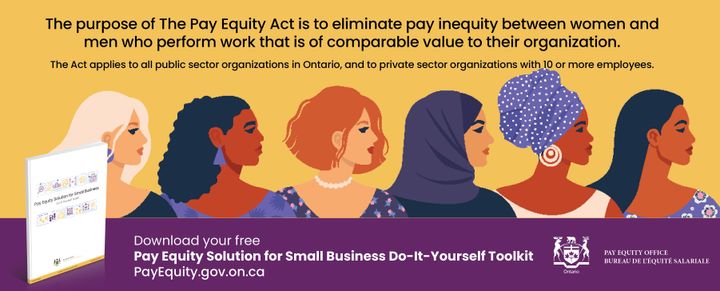Pay Transparency Toolkit
Scripts, tools and facts to support pay transparency.

Created by: Allison Venditti, Founder of Moms at Work and the Moms at Work Collective. Allison Venditti, CHRL www.thisismomsatwork.com Linkedin Instagram
What is pay transparency?
Pay transparency is about being open about how much money people are paid for the work they do. It means including the salary range in job postings and being transparent about pay processes such as pay bands, and compensation decisions, and providing all required information to understand these decisions.
Why is it important?
Pay Transparency is not only a good corporate policy, it is one of the simplest and fastest ways to prevent unconscious discrimination in hiring practices and close the pay gap.
Pay Transparency also:
- is a step towards equity and inclusion in the workplace;
- helps reduce wage gaps;
- shifts business culture and expectations toward greater equality; and,
- leads to better outcomes for workers and their families.
What is the business case for implementing pay transparency?
- Without pay transparency, DEI will not happen.
- Pay transparency helps to breed trust, which in turn improves teamwork significantly.
- Performance management: when employees understand how their pay plans are developed and how salary budgets are distributed across the organization, they in turn understand their value-add to the organization and how their individual contributions impact the bottom line. This will spur them to improve their performance in order to receive incentive pay and promotion to the next level.
- Engagement & Productivity: when employees realize they can earn more than they are currently earning, it encourages them to work harder invariably leading to an increase in career engagement thereby closing any identified skill gaps.
- Comply with legislation
- Close compensation gaps and prevent employee attrition, reduced turnover costs
Sources:
How Pay Transparency Benefits Businesses, Workspan Magazine, 2020
Managing Pay Transparency, KPMG, 2019
Pay Transparency Facts
In Canada today:
- Indigenous women working full-time, full-year earn an average of 35% less than non Indigenous men, earning 65 cents to the dollar.
- Racialized women working full-time, full year earn an average of 33% less than non racialized men, earning 67 cents to the dollar.
- Newcomer women working full-time, full-year earn an average of 29% less than non-newcomer men, earning 71 cents to the dollar.
- According to the 2012 Canadian Survey on Disability, women with a disability in Canada working full and part-time earn approximately 54 cents to the dollar when compared to the earnings of nondisabled men, equaling a wage gap of around 46%
Source: Gender Wage Gap Fact Sheet
- Only 16% of US companies currently post salaries on job postings (Source)
- There is a new law in effect from the federal government on Pay Transparency that may affect your employer. All federally regulated employers are required to provide added detail on pay transparency as part of the Pay Transparency Act, starting 2022. https://www.hrreporter.com/focus-areas/compensation-and-benefits/new-pay-transparency-rules-now-in-effect/336743
- Ontario had pay transparency legislation (Pay Transparency Act, 2018, S.O. 2018, c. 5 - Bill 3) that would require employers to share the salary, not allow them to ask for your previous salary and much more. The Ford government sent it back for ‘further consultation’ but momentum is building to bring it back in the upcoming 2022 election year.
- Effective June 1, 2022 - Prince Edward Island has pay transparency legislation which prohibits companies from asking for the current salary of applicants and requires them to disclose the salary.
- British Columbia is pursuing pay transparency legislation in a move to close the gender wage gap
- The European Union has issued a directive towards pay transparency to assist with closing the wage gap
Common Pay Transparency Myths & Assumptions (with Responses)
“But everyone will ask for the top of the range!”
Response: People understand what it takes to earn their way to the top of a range, and it helps to know if that number aligns with their career goals. Publishing the salary range allows for people to know that they are appropriately placed according to their experience and skillset, versus their peers and the market. It builds confidence and satisfaction in new hires that all is above board and they are paid adequately - no secrets.
If companies use objective criteria to set salaries and are clear of role expectations then employees and employers will have a clear understanding of where their salary amount came from.
“But people will see they are paid less than their peers, and it will create dissatisfaction!”
Response: Being transparent shows that we have nothing to hide, and that we value our staff and want to compensate them appropriately for their work. It increases engagement and employee satisfaction to know that they are paid in accordance with a structured system, in line with their experience and skills. It builds trust in the organization and provides a clear path for growth.
“People will want more! We just can’t afford that”
Response: I know at [our organization], we seek to be competitive in the market for employee compensation. If we are proud of what we have to offer employees, we should share that to attract and retain top talent. If there are gaps, that is a risk, and we should work to close them to avoid losing valued team members, which in the end would cost more than making adjustments for the gaps.
Pay transparency increases employee retention which will reduce the costs associated with employee turnover.
Starting the Pay Transparency Conversation
The following are sample conversations for those wishing to bring up pay transparency within your own organizations or with a hiring manager or recruiter.
- Elevator Pitch (via casual conversation, social media comment, etc)
Have you considered adding salary bands to our/your job postings? Pay transparency helps companies attract and keep top talent, increases employee satisfaction and aids in meeting diversity and inclusion goals. It will also help in keeping us competitive and ultimately help to close compensation gaps.
- Internal discussion at your organization re: salary disclosure in job postings:
Hi _______,
I’ve noticed that we do not post salary ranges in our company job postings, and I’d like to share some information that explains why we should consider doing so. As a company that cares about Diversity and Inclusion, Pay Transparency and Pay Equity are important topics that can help us meet our goals of preventing unconscious discrimination in hiring practices and increasing diversity in our organization.
Here’s how:
The Globe has found that working women in Canada continue to be outnumbered, outranked and out-earned by men not just at the very top, but on the way to the top and in the middle. https://www.theglobeandmail.com/canada/article-power-gap/...
Here is how Pay Transparency can lead to better business and D&I outcomes: https://allison-venditti.medium.com/the-wage-gap-is-real...
Why is this important for us?
1. Prevent attrition and attract top talent vs the competition.
2. Increase employee engagement by building trust and showcasing fair compensation in connection with experience and skills.
3. Help us meet our Diversity & Inclusion goals. Pay transparency gives groups that are systemically underpaid an even playing field in salary discussions, and leads to a more diverse workforce.
What we can do:
Include salary ranges in job posting as standard practice at [our company]
I’d like to address this in our organization. Can you help me understand the next steps to put this into action?
Thanks,
- Internal discussion at your organization about new Pay Transparency legislation:
Hi _______,
This recently came across my radar, and there is a new law in effect from the federal government on Pay Transparency that affects [our company]. All federally regulated employers with over 100 employees are required to provide added detail on pay transparency as part of the Pay Transparency Act, starting 2022. https://www.hrreporter.com/focus-areas/compensation-and-benefits/new-pay-transparency-rules-now-in-effect/336743
Why is this an issue for us ?
1. New measurement methods would show any gaps across gender or other identity groups
2. It may also prompt a legal requirement for adjusting pay in order to be in compliance.
3. If this report comes out based on the measurement methods required, and it shows we do have gender pay gaps, it puts [our company] at risk of losing staff
4. Pay transparency gives groups that are systemically underpaid an even playing field in salary discussions. As a company that seeks to be a leader in D&I in Canada, we should be leading the field here and avoid looking foolish in 2022.
What we can do:
Get as many people as possible to fill out an employee equity survey
Ask HR to measure in pay equity in our organization, in advance based on these measurement methods and close any gaps before 2022
I’d like to address this in our organization. Can you help me understand the next steps to put this into action?
Thanks,
4. External discussion with a recruiter or hiring manager:
Hi _______,
I noticed you chose not to include the pay range on this job posting. Can you share it with me?
Many companies are beginning to post salary ranges with job descriptions. There is mounting evidence that posting ranges contributes to equality and an increase of diverse and qualified candidates applying.
Some research that might be helpful to share with your team: https://allison-venditti.medium.com/the-wage-gap-is-real-but-we-can-fix-it-d38e279bb92c
I hope you reconsider your salary posting rules to show that [employer] is making changes and showing commitment to creating a diverse and equal workforce.
Thanks,
5. From recruiters/hiring managers: “what pay range are you looking for”?
Response: When I get a better feel for what is required in the role through the interview process, I would be happy to discuss fair compensation for this position. Can you share the salary range, based on entry/mid/top level experience to help me better answer this when the time comes? If pressed to give a number (i.e. must fill out a form), give a very wide pay range.
Next Steps
- Follow up with those you have spoken to
- Ask for goal setting and accountability
- Track goals that have been committed to
- Share updates on legislation
- Share examples of other companies who have been successful
What else can I do?
- Start normalizing talking about our salaries. It only benefits the employer when we keep our salaries a secret from one another.
- Influencers - help build awareness by sharing this information to your networks and starting conversations about pay transparency
- Recruiters - refuse to work for organizations that won’t disclose salary ranges upfront
- Let it be known that you don’t share job advertisements to your personal or professional networks without posted salaries ranges because keeping salaries secret reinforces discrimination
- Email the company and tell them why you aren’t applying (because not providing pay transparency is not “promoting women”)
- Call it out online (hey what’s the salary range – why aren’t you listing it?)
- Tell the Ontario government to bring back the Pay Transparency Act by emailing your local rep.
In 2018, Ontario launched a 3 year strategy designed to “close the gender wage gap, particularly where it is greatest — for Indigenous, newcomer and racialized women, and women with disabilities.” Part of that plan was the The Pay Transparency Act. The statute –was scheduled to take effect on January 1, 2019 and would make the following changes:
- Salary rates or ranges must be stated in all publicly advertised job postings;
- Candidates may not be asked about their past compensation;
- Reprisals cannot be made against employees who discuss or disclose compensation;
- Employers with one hundred or more employees and prescribed employers must track and annually report compensation gaps based on gender and other prescribed characteristics in pay transparency reports;
- The province must also publish pay transparency reports.
This Act would have removed the accepted discriminatory practices hidden under the guise of corporate culture and held companies accountable for their equality standards.
In December 2018, the Government quietly rolled out Bill 57, which halted the implementation of the Pay Transparency Act citing a need for public consultations. The public consultations closed in April 2019, and we have not heard anything since.
2022 is an election year in Ontario. Make Pay Transparency a priority by writing your local MLAs and candidates:
Sample Letter:
Dear ________:
With the upcoming election I am writing to understand your position on the implementation of the Pay Transparency Act. The Conservative Government rolled out Bill 57 to halt the process to formalize it into legislation and we have not heard anything since.
This is an important piece of legislation that will help prevent unconscious discrimination in hiring practices and close the pay gap. I am hoping you can reply to my email and provide me with how you will be supporting this legislation as it will be an integral part of my voting decision.
Best,
Send this letter to your local MPP (search by postal code here) along with the following people:
Ontario Premier, Doug Ford doug.fordco@pc.ola.org
Minister of Labour, Training and Skills Development, Hon. Monte McNaughton, Minister.MLTSD@ontario.ca
Solicitor General (responsible for the Anti-Racism Directorate). Hon. Sylvia Jones, sylvia.jones@ontario.ca
Resources & Articles:
The case for pay transparency, Mercer (US report), 2020
Government of Canada moves forward with pay transparency measures for greater equality in workplaces, Employment and Social Development Canada press release, November 25, 2020
Backgrounder: New pay transparency measures in federally regulated workplaces, Employment and Social Development Canada, 2021
Pay transparency in federally regulated workplaces, Government of Canada, 2021
Are You Ready for the New Reality of Pay Transparency?, Mercer.ca article, 2019
New pay transparency rules now in effect, HR Reporter Canada, 2021
Should You Share Your Salary With Co-Workers? Here’s What Experts Say, TIME Magazine, 2018
How to Do Pay Transparency Right, Bulletin.com article, 2021
The wage gap is real but we can fix it, Medium article by Allison Venditti, 2020
How to know your worth & stand up for yourself at work, interview with Moms at Work founder Allison Venditti, 2021
Managing Pay Transparency, KPMG article, 2018
Want to Close the Pay Gap? Pay Transparency Will Help, The New York Times, 2019
Reasons Why Salary Transparency Is Gaining Popularity, thebalancecareers.com, 2019
Fair Pay Around the World - Explore how legislation differs by country, Gapsquare.com free downloadable infographic
4 countries who have introduced pay transparency, DemandPayTransparency.org.nz
Pay Transparency and the Gender Gap, National Bureau of Economic Research, 2019


